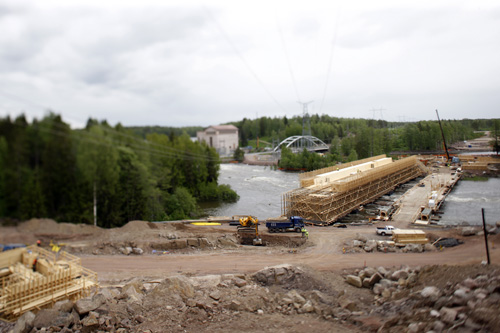Infrastructure for the future

The construction of the Koskenkylä–Kotka stretch of the E18 corridor crossing from the west coast of Finland to the Russian border is well underway. The heavily trafficked road is increasingly important for the Finnish economy.
“This is the largest infrastructure project currently under construction in Finland,” says Jaakko Kouvalainen, CEO of Tieyhtiö Valtatie 7 Oy. “The budget is almost EUR 350 million and there are around 500 people working on site. During the summer the number of persons will go up to 700.”
The E18 is the busiest and internationally most important road in Finland and stretches from Turku via the Helsinki Metropolitan Area to Vaalimaa at the Russian border. Converting the E18 into a motorway has been a long project and Mr Kouvalainen envisions that the final parts will be completed 2018–2019.
The current project comprises the construction and maintenance of 53 kilometres of motorway, of which 36 kilometres will be newly built and 17 kilometres will be a two-lane road converted into a motorway.
The construction began in December 2011 and the first parts of the road will be ready and taken into use by the end of 2013.With financing for the entire project in place and work progressing simultaneously on all six parts of the road, it enables efficient and timely completion of the project. By the end of 2014 the whole 53 kilometres will be in use and the following year all light traffic lanes and similar connections will be completed.
PPP faster and better
Tieyhtiö Valtatie 7 Oy is the project company set up by YIT, Destia, Meridiam Infrastructure and Ilmarinen Mutual Pension Insurance Company. The project company is in charge of executing the project based on the Finnish Transport Agency’s plans. The project is financed as a public–private-partnership, also known as a lifecycle model.
According to Mr Kouvalainen the benefits of the lifecycle model are substantial.
“The core benefit from the society’s point of view is the fact that a large road can be built very fast and taken into use quickly. This project would take significantly longer if financed through budget funding.”
The Koskenkylä-Kotka motorway will be built in three years followed by a maintenance period of 12 years during which the project company is responsible for the roads availability for use. Compared to similar projects in Finland and abroad the period is extremely short, as it commonly is as long as 20 to 30 years.
“The PPP model also forces the service provider to produce an excellent end result as the liability period is much longer than in conventional projects where it normally is two years,” he continues.
The current project is the third PPP road project in Finland. The most recent one was the Lohja–Muurla distance, completed in 2009, also a part of the E18 corridor. NIB has co-financed all three projects.
“One challenge of the PPP model is the vast amount of documentation required and the management of it. Another one is the fact that eight years in between projects is a long time and the experience gained during previous projects is at least partly lost. For the future I hope that some standardisation of the documentation would be reached,” Kouvalainen concludes.
Green and safe motorway
The road was planned in collaboration with the “Green motorway” initiative, started by the municipalities and businesses in the area. The aim is to promote sustainable development by, for example, using renewable energy in traffic and road maintenance.
“We are going for more environmentally friendly solutions, such as using solar panels for electricity generation for the service buildings and cafes along the road, LED lighting with an intelligent steering system. In addition, the use of wood is favoured both in service buildings, bridges and sound barriers. A special feature is the installation of tubing for electric car charging stations,” Mr Kouvalainen explains.
The project’s land mass balance is good. As the necessary grit is produced onsite, there is less need to transport material to the site, resulting also in significant petrol savings. Over-digging, which sometimes is a challenge in similar projects, is minimized by an excavator system controlling the digging depth and area.
Improving the safety of the heavily trafficked road is another important aspect of the project and welcomed by the population in the area.
“A big part of the traffic consists of large trucks passing through residential areas. It is really a very dangerous stretch of road, with over 100 accidents resulting in two to three casualties a year,” Kouvalainen continues.
The traffic safety will also be improved by telematic surveillance offering information on weather conditions and speed limits. The system will be partly installed also beyond the current road project.
Safety and environmental responsibility is also stressed throughout the construction phase. Training is compulsory for all staff members as well as visitors at the sites. Big signs in various languages remind of the protection gear to wear and booklets for reporting safety breeches are handed out to everyone. The management reports weekly on safety statistics and keeps track of accident free days.
Converting the existing road to a motorway also leads to socio-economic benefits for the region. The municipalities, towns and villages understand the potential of business opportunities that the constantly growing traffic from Russia brings. Future plans include, among other projects, to develop services such as housing, tourism and logistics.
